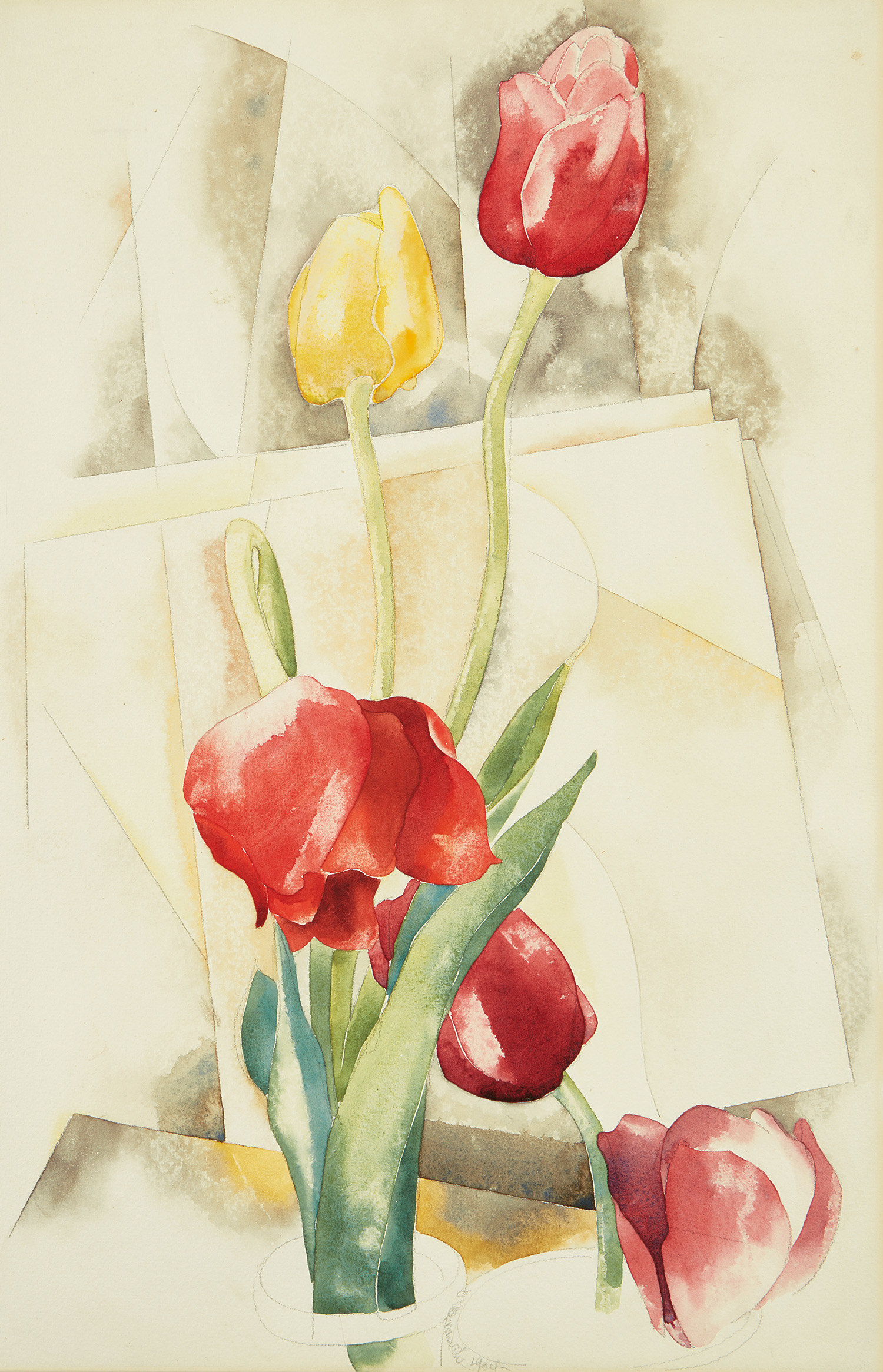

147
Charles Demuth
Tulips
signed and dated "C. Demuth 1924" lower center
watercolor and graphite on paper
17 7/8 x 11 7/8 in. (45.7 x 30.3 cm.)
Executed in 1924.
Full-Cataloguing
Held in the revered collection of Margaret V. and Samuel A. Lewisohn, Charles Demuth’s Tulips and Daylilies are exquisite watercolors presenting the artist’s celebrated depictions of the floral still life. Beautifully rendered with precise lines, angular forms and vivid red, green and yellow hues, both encapsulates the Precisionist style that Demuth pioneered in the early 20th century. Using a wash-and-blotter technique, Demuth imbues the scenes with rich texture – here beautifully conveying the effects of shadow and light. Executed in 1918 and 1924, respectively, these works were created at the height of Demuth’s career, for it was in 1923 that the Metropolitan Museum of Art in New York added one of his works to their collection.
While living in his native Lancaster, Pennsylvania, for most of his life, Demuth was well-established within the world of modern art, and frequently traveled to Europe and New York. Studying in Paris, he was notably absorbed into the avant-garde scene, meeting Marsden Hartley, through whom he would later meet Alfred Stieglitz and become a core member of Stieglitz’s circle of American Modernists. Together with Charles Sheeler and his friend and contemporary Georgia O'Keeffe – who would later inherit much of Demuth’s estate – he notably developed the quasi-Cubist art movement of Precisionism. Similar to O’Keeffe, Demuth focused with vigor on flowers and vegetation, yet he sought to strip his favored motif of flowers down to geometric, angular shapes.
"Search the history of American art," wrote Ken Johnson in The New York Times, "and you will discover few watercolors more beautiful than those of Charles Demuth“ (Ken Johnson, "A Watercolorist Who Turned His Hand to Oils of Heroic Vision", The New York Times, February 27, 2008, online). Indeed, while Demuth frequently explored industrial and urban architectural motifs, his legacy is perhaps above all defined by remarkable depictions of the lavish garden surrounding his home in Lancaster. Tulips exemplifies how Demuth began to increasingly probe the spatial possibilities of his watercolor still lifes in the 1920s. Increasingly isolating his compositions against a white background, Demuth cast the negative white space of the paper as a compositional element. As Emily Farnham observed of his use of the white ground, “It was notably in his watercolor still lifes that he habitually placed exquisitely delineated positive objects (peaches, eggplant, striped kitchen towels) against a luminous unpainted ground. This device has reappeared during the sixties in the works of Californian [Wayne] Thiebaud, who employs pure white grounds behind relief-like human figures as means toward the psychological and technical isolation of his subjects” (Emily Farnham, Charles Demuth: Behind a Laughing Mask, Norman, 1971, p. 185).
While living in his native Lancaster, Pennsylvania, for most of his life, Demuth was well-established within the world of modern art, and frequently traveled to Europe and New York. Studying in Paris, he was notably absorbed into the avant-garde scene, meeting Marsden Hartley, through whom he would later meet Alfred Stieglitz and become a core member of Stieglitz’s circle of American Modernists. Together with Charles Sheeler and his friend and contemporary Georgia O'Keeffe – who would later inherit much of Demuth’s estate – he notably developed the quasi-Cubist art movement of Precisionism. Similar to O’Keeffe, Demuth focused with vigor on flowers and vegetation, yet he sought to strip his favored motif of flowers down to geometric, angular shapes.
"Search the history of American art," wrote Ken Johnson in The New York Times, "and you will discover few watercolors more beautiful than those of Charles Demuth“ (Ken Johnson, "A Watercolorist Who Turned His Hand to Oils of Heroic Vision", The New York Times, February 27, 2008, online). Indeed, while Demuth frequently explored industrial and urban architectural motifs, his legacy is perhaps above all defined by remarkable depictions of the lavish garden surrounding his home in Lancaster. Tulips exemplifies how Demuth began to increasingly probe the spatial possibilities of his watercolor still lifes in the 1920s. Increasingly isolating his compositions against a white background, Demuth cast the negative white space of the paper as a compositional element. As Emily Farnham observed of his use of the white ground, “It was notably in his watercolor still lifes that he habitually placed exquisitely delineated positive objects (peaches, eggplant, striped kitchen towels) against a luminous unpainted ground. This device has reappeared during the sixties in the works of Californian [Wayne] Thiebaud, who employs pure white grounds behind relief-like human figures as means toward the psychological and technical isolation of his subjects” (Emily Farnham, Charles Demuth: Behind a Laughing Mask, Norman, 1971, p. 185).